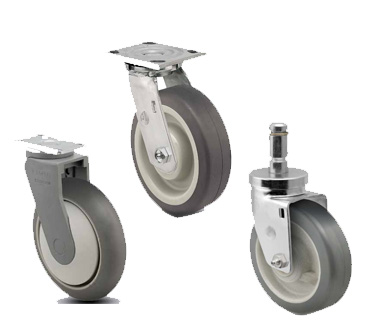
Are you looking to purchase casters for your business? Featuring a rolling wheel housed inside a protective, swiveling frame, casters can turn stationary objects into mobile objects. After installing them on the bottom of a stationary object, you can roll the object to a new location. While all casters feature this basic design, their specifications and features vary. So, consider the five following things when choosing casters for your business.
#1) Mounting Method
Casters are typically mounted in one of several ways. Some casters are designed with a flat plate on top that can be bolted into an object, whereas others feature stems that are screwed or snapped into an object. There are also casters that use brackets for vertical mounting.
#2) Housing Material
Also known as a rig or yoke, the housing is the fixed frame in which the caster’s wheel is located. Caster housings are available in several different materials, some of which include anodized aluminum alloy, zinc-plated steel, oil-coated steel and traditional stainless steel.
#3) Load Capacity
Load capacity refers to the maximum weight a caster can support. When used on object exceeding the caster’s load capacity, the housing may collapse or break. Some of the cheapest, lowest-quality casters — usually found in office chairs and other rolling furniture — have a load capacity of just 150 to 200 pounds. However, there are stronger, higher-quality casters that can support up to 100,000 pounds. When choosing casters for your business, consider the weight of the object on which they’ll be mounted. If you’re going to mount casters on a 500-pound object, they should have a load capacity of at least 500 pounds, preferably more.
#4) Wheel Material
You should also consider the material or materials from which the wheels are made. The wheels are usually made of a different material than the housing, with some of the most common materials used to make wheels being cast iron, rubber, nylon, aluminum, polyolefin and polyurethane. Each of these materials has its own characteristics, though all can produce high-quality caster wheels.
#5) Heat Resistance
Casters are often used in manufacturing factories and welding facilities where they are exposed to extreme heat. In cases such as this, it’s important to choose casters that can withstand this heat. At roughly 200 degrees, the wheel tread and lubricates of casters begins to break down, which can lead to total failure of the caster. Some casters, however, are designed with heat-resistant lubricates and components to withstand high temperatures.
